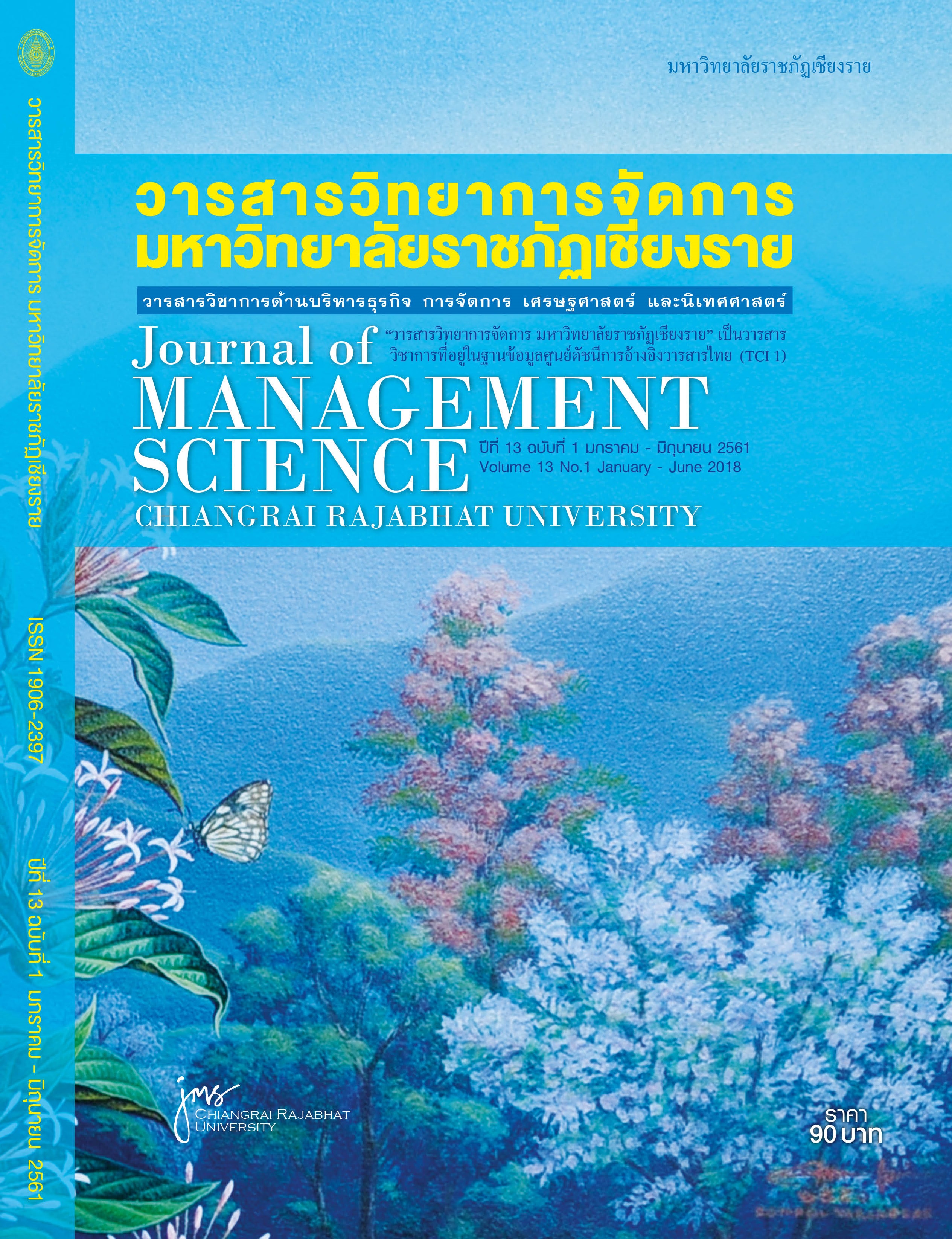Managing and Developing Weaving Group in Wiangyong Sub-District, Muang District, Lamphun Province
Main Article Content
Abstract
This research was a participatory action research to study the context of a weaving group in Wiangyong Sub-District, Muang District, Lamphun Province, to examine management problems in marketing, production and finance of the group, and to find out forms, structures, methods and activities suitable for managing weaving group in Wiangyong Sub-District, Muang District, Lamphun Province. The sample of the research was 17 members of the weaving group. The data was collected by interview, enquiry, observation and focus group discussion as a knowledge forum.
The results of the research showed that a group founder was Phra Kru Paisarn Teerakhun, the abbot of Wat Ton Kaeo, who was responsible for every aspect and provided the master budget. The group adhered to the person and his prestige. Objectives of establishing the group were to conserve and further local wisdom in weaving. The members of the group lived together as the relatives.
The research found the management problems of the group as follows: no action plans in every aspect, informal group structure, no clear systems in selecting members, no controls of workpiece quantity and working time, and only head of the group controlling work quality. In term of marketing, only head of the group could design the pattern and there was only weaving as a product. There were no brand name and no clear price tags. There was no clear pricing. The product was distributed only at the group location. There were no sales promotion and public relations. In term of production, buildings and equipment used for production were quite old and deteriorated, and members had different skills of weaving. In terms of finance and accounting, accounts and sales volume were not recorded, and funds came from only one source.
The research revealed forms, structures, methods and activities suitable for managing the group as follows: holding meetings of group members, changing the group structure to be more formal, dividing works according to individual abilities and proficiency, conducting training occasionally, more members responsible for examining and controlling work quality, finding successors to carry on and conserve weaving, government sector participating in listening to problems and supporting the budget, increasing motivation in buying to customers by offering promotions according to festivals, and summarizing monthly incomes and expenses to help make decisions and plan for operations more quickly.
Article Details
Views and opinions expressed in the journal do not necessarily reflect those of the editors.
References
Pha Yok Lamphun Weaving. (2011). Retrieved December 20, 2014, from www.phayok-lamphun.org. (in Thai)
Wongwirach, Kajohnsak. (2008). A Study of Occupational Management of Farmers Growing Pesticide Residue Free
Vegetables of Ban Cham, Village No. 6, Pong Yang Kok Subdistrict, Hang Chat District, Lampang. Final Report. The Thailand Research Fund. (in Thai)
Moonlasri, Jantira. (2004). Approach to Develop the Community Business of Rattan Handicraft Career Development of
Ban Na Kra Seng, Loei Province. Study Problem. Master’s Thesis, Department of Business Administration, Faculty of Business Administration, Mahasarakham University. (in Thai)
Kanchanachitra, Chiraphan. (2015). Community Development. Ramkhamhaeng University Press. (in Thai)
Promsri, Chaiyaset. (2014). Contemporary Leadership. Bangkok: Panyachon. (in Thai)
Aksaeng, Duangruethai. (2009). The Knowledge Management Process for Local Wisdom about Organically-Dyed
“Mudmee” Thai Silk. Master’s Thesis, Department of Business Administration, Faculty of Business Administration, Khon Kaen University. (in Thai)
Suntiwong, Thongchai. (2002). Organization and management. Bangkok: Thai Watana Panich Co.,Ltd. (in Thai)
Yavirach, Natepanna. (2013). Leadership and Strategic Leader. Bangkok: Chulalongkorn University Press. (in Thai)
Wingworn, Boontawan. (2013). Entrepreneurship in the Globalization Era. Bangkok: Chulalongkorn University Press. (in Thai)
Khwanchu, Panisara. (2009). Role of Group Leaders in the Conservation of Pha Tho Yok Dok of Ton Kaew Temple
Textile Group Wiang Young Sub-district, Mueang District, Lumphun Province. Master’s Thesis, Department of Public Administration, Faculty of Political Science, Chiang Mai University.
Wonganutaroj, Preeyaporn. (2010). Academic Management. Bangkok: Bangkok Media. (in Thai)
Upata, Monchanok. (2015). Local Wisdom Management of Cloth Weaving Group in Wiangyong Sub-District, Amphoe Mueang, Lamphun Province. Complete Research. Office of the Higher Education Commission.
Phommaung, Ludda. (2004). Role and Quality of Working Life of Members of the Pottery Group, Ban Mueang Kung,
Tambon Nong Khwai, Amphoe Hang Dong, Changwat Chiang Mai. Chiang Mai University.
Chompoopitak, Walaiporn and Dorsaeng, Benjamin. (2003). Production Group Management of Pesticide Residue Free
Vegetables, Tambon Mae Kon, Amphoe Mueang Chiang Rai. Bangkok: The Thailand Research Fund. (in Thai)
Wungdee, Siriwan. (2007). Community Enterprise Development Strategy for Self-sufficiency: Case Study of Rice
Production Community Enterprise of Tambon Pho Phraya, Suphan Buri. Complete Research. The Thailand Research Fund. (in Thai)
Bangmo, Somkid. (2013). Modern Organization Management. Bangkok: Faculty of Public Administration, National
Institute of Development Administration. (in Thai)
Chantavanich, Supang. (2008). Qualitative Research. 2nd Printing. Bangkok: Chulalongkorn University. (in Thai)
Suksriwong, Sakorn. (2008). Management: From the Executive's Viewpoint. 4th Printing. Bangkok: G.P. Cyberprint. (in Thai)
Suwanmongkol, Suthanya. (2001). Factors Related to Weaving Career, Lamphun Province. Master’s Thesis. Faculty of Education. Chiang Mai University. (in Thai)
Federation of Accounting Professions. (2009). Importance of Accounting and Financial Statements. Retrieved December 20, 2014., from https://www.fap.or.th/index. (in Thai)
Bartol, K., Matin, D. (1898). Management, Baston: McGraw-Hill.
Bateman, T.S.,& Snell, S.A. (2009). Management: Leading& Collaborating in the Competitive World. New York: McGraw-Hill.
Donnelly,Gibson and Ivancevich. (2007). Fundamentals of Management. New York: McGraw-Hill Higher Education.
______________. (2000).Organizations: Behavior, Structure, Processes. New York: McGraw-Hill Higher Education.
Philip Kotler.(2002). Marketing Management. United States: Book Trade Cloth.
Rule,L. &Byars. (2002). Management: Skill and Application. (10th). United States: McGraw-Hill


